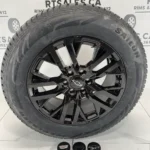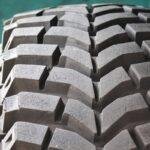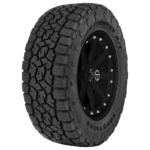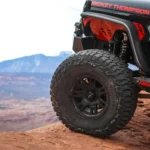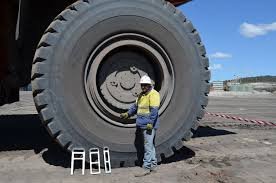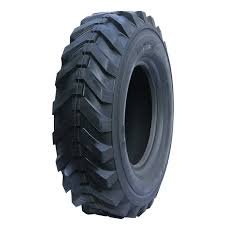The Ultimate Guide to 235/75R15 All Terrain Tyres
Is your trusty SUV or pickup truck ready for a new set of boots? If you’re running a classic 4×4 like a Jeep Cherokee (XJ), an older Ford Ranger, or a Toyota 4Runner, chances are you’re shopping for 235/75R15 all terrain tyres. This specific size is a legend in the off-road and utility world, offering a perfect blend of rugged capability and everyday drivability. But with so many options on the market, how do you choose the right set for your vehicle and your adventures? This comprehensive guide dives deep into everything you need to know about 235/75R15 all terrain tyres, from decoding the numbers on the sidewall to selecting the best brand for your needs and ensuring your safety on and off the pavement.
What Does 235/75R15 Actually Mean?
Before we explore the “all terrain” part, let’s break down the code that is your tyre size. Understanding these numbers is key to making an informed purchase.
Section Width (235)
The first number, 235, refers to the tyre’s section width in millimeters. This is the linear distance from the outermost sidewall to the innermost sidewall at the tyre’s widest point when mounted on a specified width rim. In simpler terms, it’s how wide your tyre is.
Aspect Ratio (75)
The second number, 75, is the aspect ratio. This is a percentage that represents the height of the tyre’s sidewall relative to its section width. So, a 75-series tyre means the sidewall height is 75% of 235mm. A lower number (e.g., 60) indicates a shorter, stiffer sidewall often found on sporty vehicles, while a higher number like 75 offers a taller sidewall, which is great for absorbing off-road impacts and providing a more comfortable ride.
Construction (R) and Rim Diameter (15)
The “R” stands for Radial construction, which is the standard for modern tyres. Radial ply layers run perpendicular to the direction of travel, offering better fuel efficiency, tread life, and road grip compared to older bias-ply designs. The final number, 15, is the wheel or rim diameter in inches. This tells you that this tyre is designed to fit on a 15-inch wheel.
Why Choose All Terrain Tyres in 235/75R15?
All Terrain (A/T) tyres are the undisputed champions of versatility. They are the perfect compromise for the driver who spends 80% of their time on the road but wants the confidence and capability to tackle a dirt trail, a snowy pass, or a muddy campsite on the weekend.
The 235/75R15 size is particularly well-suited for this role. Its generous sidewall height provides crucial cushioning against rocks, potholes, and other off-road obstacles, helping to protect your wheels from damage. This size was extremely common on SUVs and trucks from the 80s, 90s, and early 2000s, meaning there is a huge variety of excellent all terrain tyres for sale in this specific dimension.
Top Brands and Models for 235/75R15 All Terrain Tyres
Several leading manufacturers produce outstanding tyres in this size. Here are some of the most respected models to consider:
BFGoodrich T/A KO2
Often considered the gold standard, the KO2 is legendary for its durability and tenacious off-road grip. It features a rugged sidewall bruise guard and excellent traction in mud, snow, and sand, all while maintaining respectable road manners. It’s a top choice for serious enthusiasts.
Goodyear Wrangler All-Terrain Adventure with Kevlar
Goodyear leverages its racing heritage in this tough tyre. The inclusion of a Kevlar®-reinforced carcass provides exceptional puncture resistance, making it ideal for rocky terrain. It also offers solid wet weather performance and a quiet highway ride. Explore more at the Goodyear Official Website.
Yokohama Geolandar A/T G015
If your driving is more weighted towards highway use with occasional off-road excursions, the Geolandar A/T G015 is a fantastic option. It is renowned for its low road noise, smooth ride, and excellent wet weather braking. It’s a more road-biased all-terrain that still has the chops for light trails. Check out the full range on the Yokohama Tire Official Website.
Other Notable Mentions
Other brands like Bridgestone (Dueler A/T Revo 3), Michelin (LTX A/T 2), and Continental offer compelling options in or near this size range, often focusing on longevity and all-weather safety.
Actionable Advice: Choosing and Maintaining Your Tyres
How to Select the Right Tyre for You
Ask yourself these questions:
- What’s my driving mix? (e.g., 70% highway, 20% forest roads, 10% mud)
- What’s most important? (Tread life? Off-road grip? Snow performance? Ride comfort?)
- What’s my budget? (Include costs for mounting, balancing, and an alignment)
Read professional tests from sources like Tire Rack Testing and Reviews and owner reviews to see how specific models perform in your priority areas.
Essential Maintenance for Longevity and Safety
To get the most out of your investment and ensure your safety, follow these best practices:
- Regular Pressure Checks: Check tyre pressure at least once a month when the tyres are cold. Incorrect pressure leads to uneven wear, poor fuel economy, and reduced traction. Refer to your vehicle’s placard (usually on the driver’s door jamb) for the recommended PSI.
- Rotation is Key: Rotate your tyres every 5,000 to 8,000 miles. This promotes even tread wear across all four tyres, extending their overall life. All-wheel drive vehicles are particularly sensitive to differing tread depths.
- Tread Depth Checks: Use the penny test! Insert a penny into the tread groove with Lincoln’s head upside down. If you can see the top of his head, your tread depth is less than 2/32″ and it’s time for new tyres. For serious off-road or wet weather driving, consider replacing them sooner.
- Visual Inspections: Before long trips, look for any signs of damage—cuts, cracks, bulges, or objects embedded in the tread.
Safety Considerations for All Terrain Tyres
While capable, all terrain tyres have unique safety characteristics. The Tire Safety Organization emphasizes that proper maintenance is the cornerstone of safety.
- On-Road Manners: Aggressive tread patterns can sometimes lead to longer stopping distances on wet pavement compared to a highway tyre. Adjust your following distance, especially in rain.
- Load Range and Inflation: Many A/T tyres in this size are Light Truck (LT) rated, which have higher load capacities but also require higher inflation pressures than Passenger (P) tyres. It is critical to inflate them to the pressure specified for your vehicle’s load, not the maximum pressure on the tyre’s sidewall. Under-inflating an LT tyre can cause dangerous overheating.
- Winter Driving: While many A/T tyres carry the Three-Peak Mountain Snowflake (3PMSF) symbol, indicating severe snow service capability, they are not a substitute for dedicated winter tyres on ice. Drive with extra caution in severe winter conditions.
Expert Insights: Getting the Most from Your Set-Up
We consulted with off-road specialists and mechanics for their top tips:
- “Always get a professional alignment after installing new tyres. An out-of-alignment vehicle will chew through a expensive set of A/Ts in no time.” – Mike R., Master Technician.
- “Don’t forget about your spare! If you’re upgrading to a new set of 33 Inch All Terrain Tyres or even just a new model, ensure your spare is a matching size and tread pattern. Being stuck with a mismatched, undersized spare can cause damage to AWD systems.” – Jen T., Overland Guide.
- “Consider the weight. LT tyres are heavier than P-metric tyres. This can slightly impact acceleration and fuel economy on older vehicles. It’s a trade-off for the increased durability.” – David L., Automotive Journalist at Motor Trend Magazine.
For a broader look at equipping your vehicle, our guide on All Terrain Tyres for 4×4 Vehicles covers everything from sizing to performance metrics.
Frequently Asked Questions (FAQ)
What vehicles use a 235/75R15 tyre?
This was a very common size for 2-door and 4-door SUVs and compact trucks from the late 1980s through the early 2000s. Common applications include: Jeep Cherokee (XJ), Jeep Wrangler (YJ, TJ), Ford Bronco II, Ford Ranger, Chevrolet S-10, GMC Sonoma, Toyota 4Runner (1st and 2nd gen), and Nissan Pathfinder (WD21).
Are 235/75R15 tyres good in snow?
Many modern all-terrain tyres in this size are rated for severe snow service (marked with the 3PMSF symbol) and perform admirably in snow. They are far superior to all-season highway tyres. However, for the ultimate safety on ice and hard-packed snow, a dedicated winter tyre is still the best choice.
How long do all terrain tyres typically last?
Treadlife varies greatly by brand, model, and driving habits. You can expect a range of 40,000 to 60,000 miles from a quality set of all-terrain tyres. Softer, more aggressive compounds may wear faster, while harder, road-biased compounds will last longer. Regular rotation is the single biggest factor in maximizing tread life.
Can I use a 235/75R15 tyre if my original size was different?
It is essential to choose a tyre size that is approved for your vehicle. While 235/75R15 is a very common size, you should always cross-reference your owner’s manual or the tyre placard on your vehicle’s door jamb to confirm it is a correct fitment. Slight variations can affect speedometer accuracy, clearance, and vehicle handling.
Where can I find reliable reviews and testing data?
Independent testing from organizations like Consumer Reports and expert reviews from automotive publications like Edmunds Automotive Guide are invaluable resources. Also, check the American Automobile Association for tyre safety and maintenance tips.

